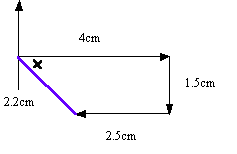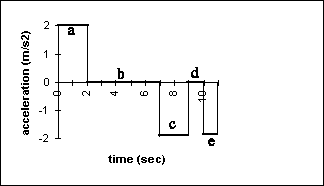Use a scale of 2km = 1cm.
So 8km due east would be represented by 4cm due east.
Likewise 3km due south would be represented by 1.5cm etc.
Once you have done the scale diagram it should look like this...

The displacement is represented by the blue line and is found to be about 2.2cm long.
Remember 1cm stands for 2km so 2.2cm stands for 4.4km.
Now displacement is a vector. So you need to state a direction in degrees.
This is done by measuring the angle marked by the cross by a protractor!
This angle is found to be approximately 30 o
So displacement is 4.4km, 30o south of east.
b) The average velocity is given by:
displacement / time
We then have 4.4km/3.5h = 1.3 km/h.
Therefore the average velocity is 1.3km/h 30o south of east.
(error / actual measurement) x 100
| % error in initial velocity | ( 0.1 / 5.3 ) x 100 | = 1.9% |
| % error in final velocity | ( 0.1 / 8.8 ) x 100 | = 1.1% |
| % error in distance measured | ( 0.01 / 50 ) x 100 | = 0.02% |
The largest % error is 1.9%.
To find the acceleration we put down all our kinematic variables in a list filling in the ones we know and putting a question mark at the one we want to find:
u = 5.3cm/s
v = 8.8cm/s
a = ?
S = 50cm
t =
We will use the equation v2 = u2 + 2aS
Rearranging for the acceleration a, we obtain
a = (v2 - u2)/2S
a = (8.82 - 5.32)/2x50
a = 0.5 cm/s2
a = 0.5 cm/s2
 1.9%
1.9%If you had to give the measurement plus the absolute error then you would have to work out 1.9% of 0.5 = 0.1 ( to 1decimal place)
Your final answer would be
0.5 cm/s2
 0.1cm/s2
0.1cm/s21. Find how long the javelin was in the air.
2. Use the horizontal component of the velocity and the time you found in step 1. to calculate the horizontal displacement
A good idea is to split your page into two halves. One half for the vertical motion and the other half for the horizontal motion.
| Vertical Component | Horizontal Component |
 u = 28sin45 = 19.8m/s Use the kinematics list: u = 19.8m/s v = 0 ( at the top vertical velocity = 0m/s) a = -9.8m/s2 ( g downwards taken as negative) S = t = ? Use equation v = u + at Rearranging to find t gives: t = (v - u) / a t = (0 - 19.8)/-9.8 t = 2.0 sec So the total time in the air is double this answer, assuming that no air resistance is present, ie the time to go up is the time to come down. Time of the flight is 4.0s. |  u = 28cos45 u = 19.8m/s Horizontal displacement = horizontal velocity x time Shoriz = uhoriz x t Shoriz = 19.8 x 4 Shoriz = 79.2m |
Repeating the calculation for angle = 35 degrees gives horizontal distance = 75.17m.
And for angle = 55 degrees the horizontal distance = 75.17m.
It would appear that the best angle would be 45 degrees to the horizontal.
 |
Part (a) a = (v - u )/t a = (4 -0)/2 = 2m/s2 Part (b) a = 0 since it is constant velocity. Part (c) a = ( 0 - 4 )/2 = -2m/s2 Part (d) a = 0 since constant velocity. Part (e) a = (-2 -0)/1 = -2m/s2 |
Plotting these values of acceleration onto a graph gives:

b) To find the total displacement you must find the area under the graph.
Remember those areas under the time axis must be subtracted as this indicates displacement in the opposite direction.
 |
Area 1 = 0.5 x 2 x 4 = 4 Area 2 = 5 x 4 = 20 Area 3 = 0.5 x 2 x 4 = 4 Total area = 28m Now area 4 is under the axis so we treat this as displacement in the oppposite direction. Therefore Area 4 = 0.5 x 1 x 2 = 1 So total displacement is 28m - 1m = 27m |
u = 0m/s (starts from rest.)
v
a = -9.8m/s2
S = -55m ( since displacement down is taken as negative.)
t = ?
We need a kinematics equation with u, a, S, and t.
We use S = ut + 1/2 at2
Putting in the numbers gives
-55 = (0 x t) + 1/2 x (-9.8) x t2
-55 = -1/2 x9.8 x t2
-55 = -4.9 t2
-55 / -4.9 = t2
11.2 = t2
So t = 3.4 seconds
